Abstract
1. The aim of this study was to provide direct evidence that sympathetic outflow to the skin in humans is governed by central neural mechanisms. 2. Microneurographic measurements of skin sympathetic nerve activity (SNA) from the personal nerve was performed in nine subjects during: (1) static hand grip at 10, 20 and 30% maximal voluntary contraction (MVC); and (2) attempted static hand grip during partial neuromuscular blockade produced by injection of vecuronium. 3. Two minutes of static hand grip at 20 and 30% MVC (force output, 9.6 +/- 0.2 and 14.4 +/- 0.3 kg, respectively) evoked significant increase in skin SNA that were graded to the intensity of the exercise. Static hand grip at 10% MVC (force output, 4.8 +/- 0.1 kg) caused a small but insignificant increase in skin SNA. 4. During vecuronium-induced neuromuscular blockade, subjects failed to maintain a force output equivalent to the output produced during 10% MVC before vecuronium (force output: 1st min, 4.4 +/- 0.6 kg; 2nd min, 2.1 +/- 0.4 kg), in spite of maximal effort being applied. This attempted hand grip exercise consistently evoked considerable increase in skin SNA that did not significantly differ from the responses produced by hand grip at 30% MVC; total skin SNA increased by 246 +/- 93% during 2 min of attempted hand grip and increased by 243 +/- 77% during 2 min of static hand grip at 30% MVC (means +/- S.E.M., P < or = 0.05). These increase in skin SNA were not due to activation of resting muscles because measurements of surface electromyography showed no activity in resting forearm muscles during static or attempted hand grip exercise. 5. This study provides direct neurophysiological evidence that central motor command can activate sympathetic outflow. During static hand grip, central motor command is the primary mechanism that stimulates sympathetic outflow to skin.
Full text
PDF


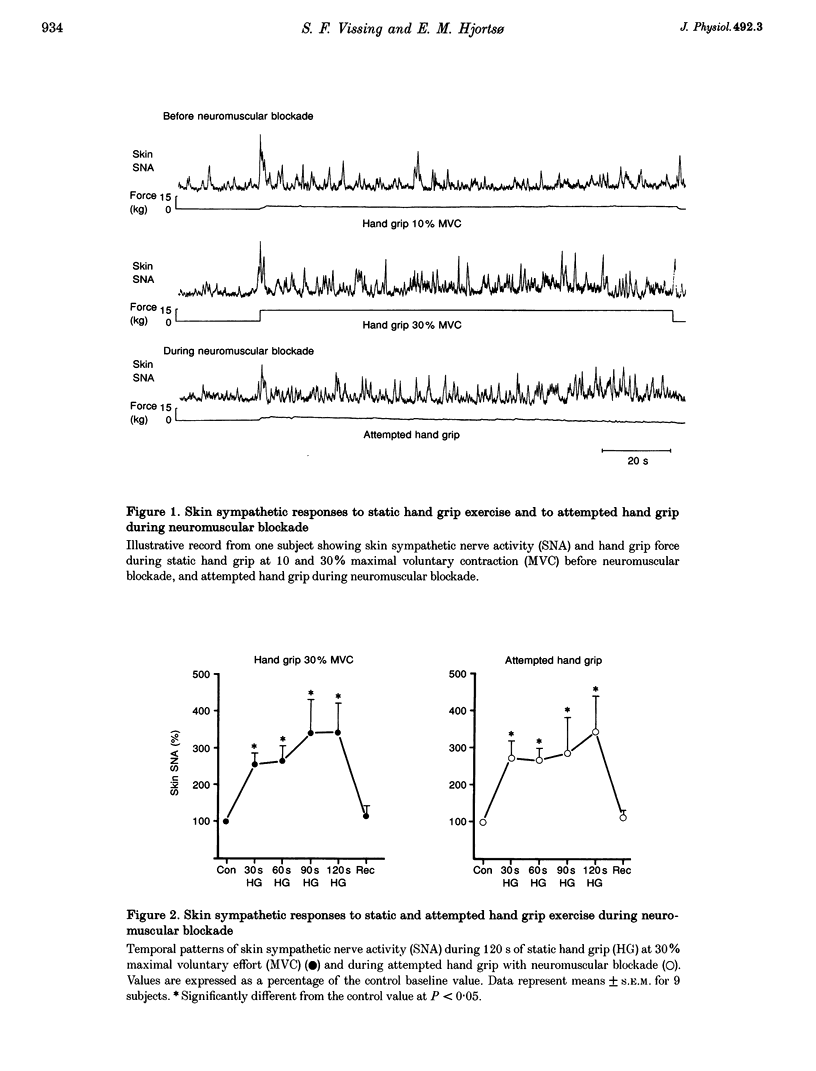
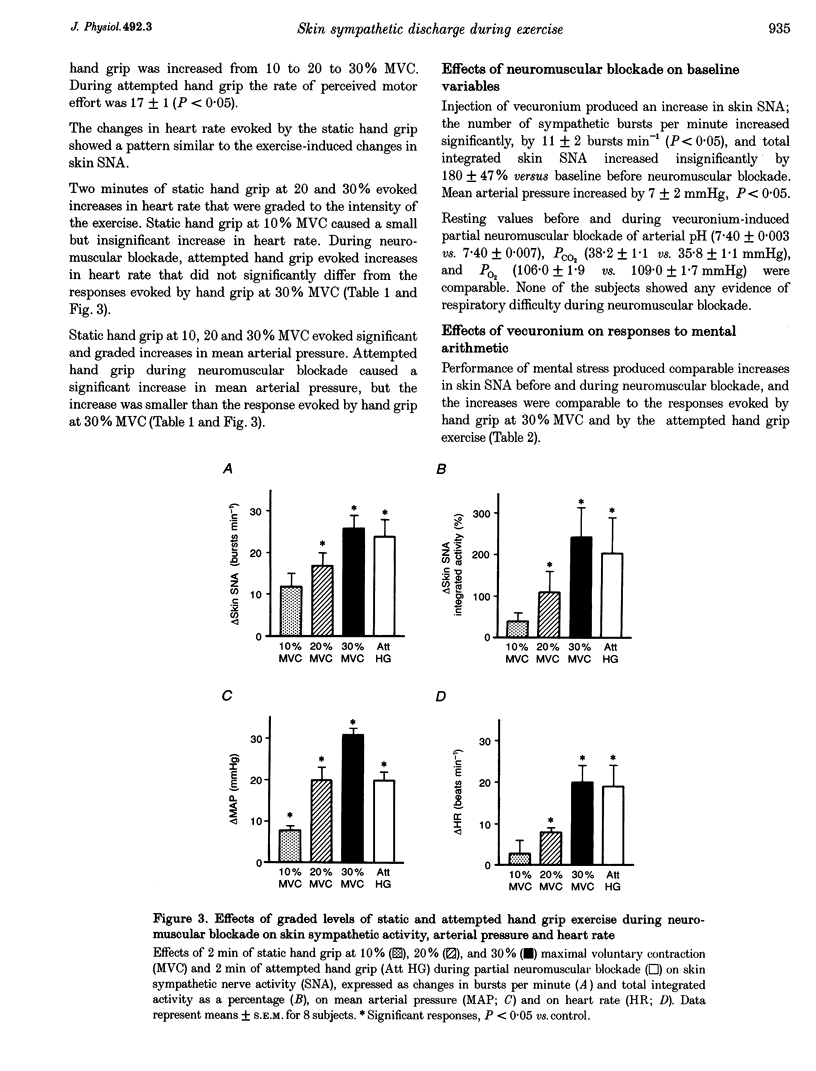
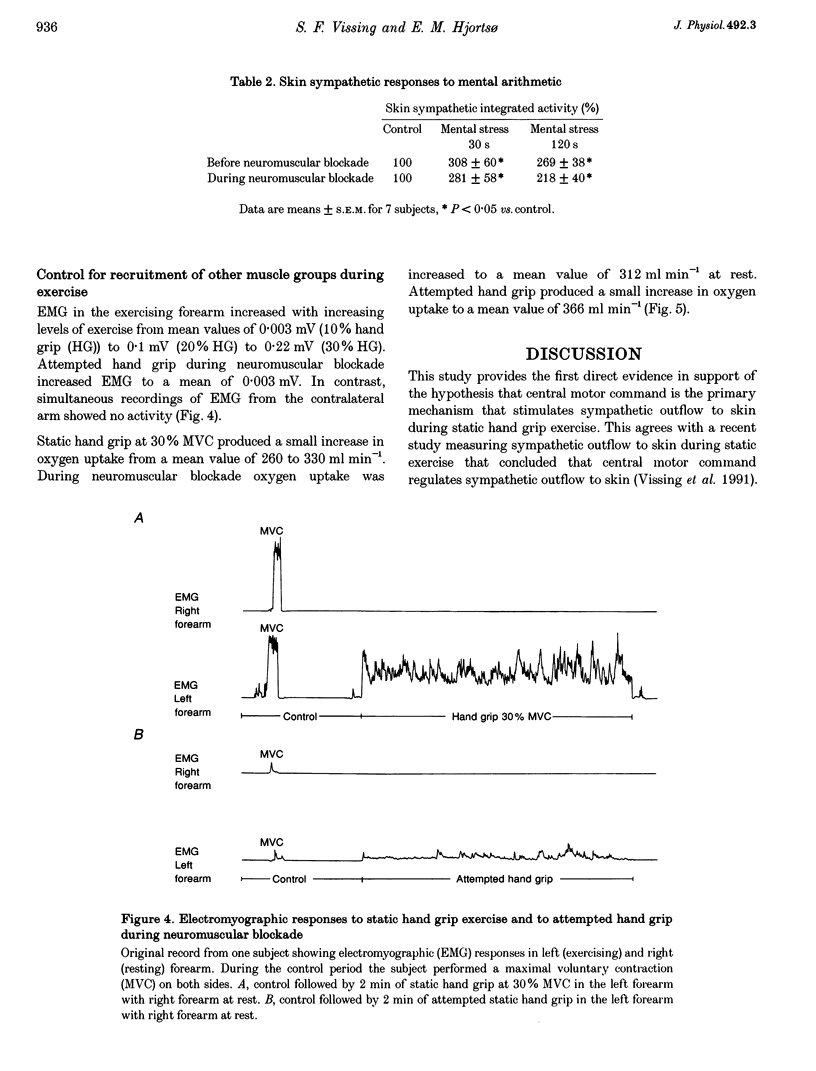
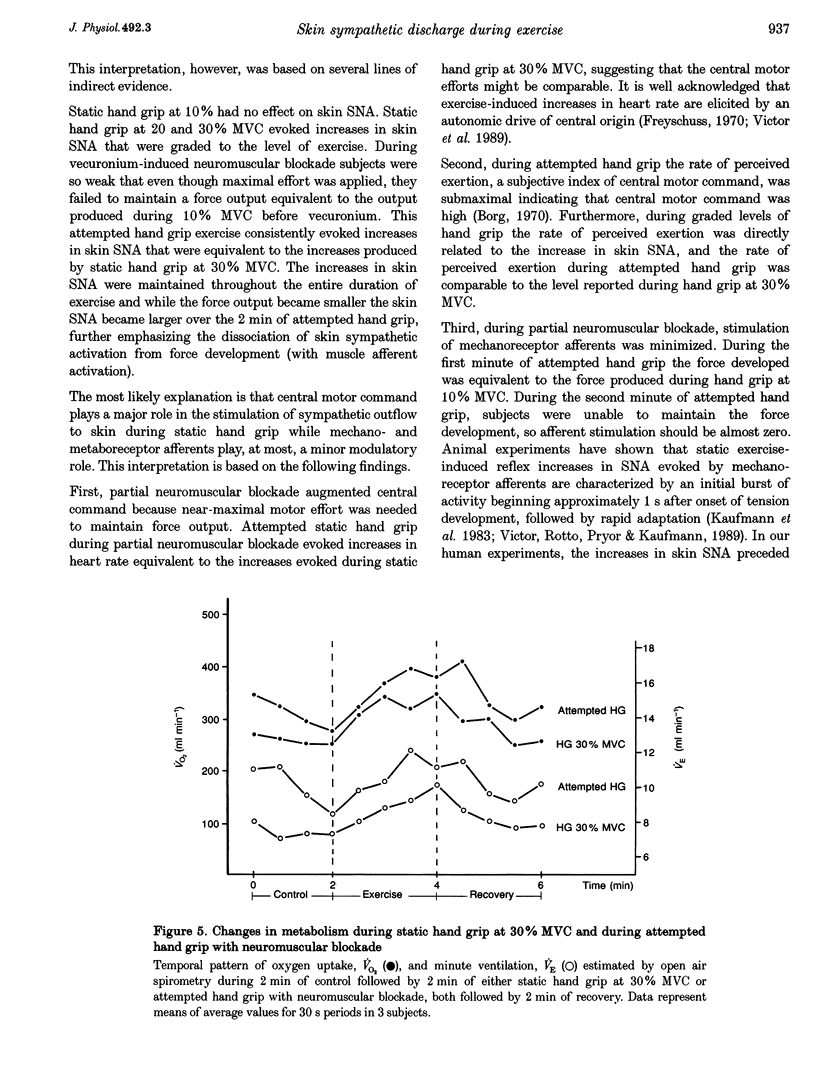

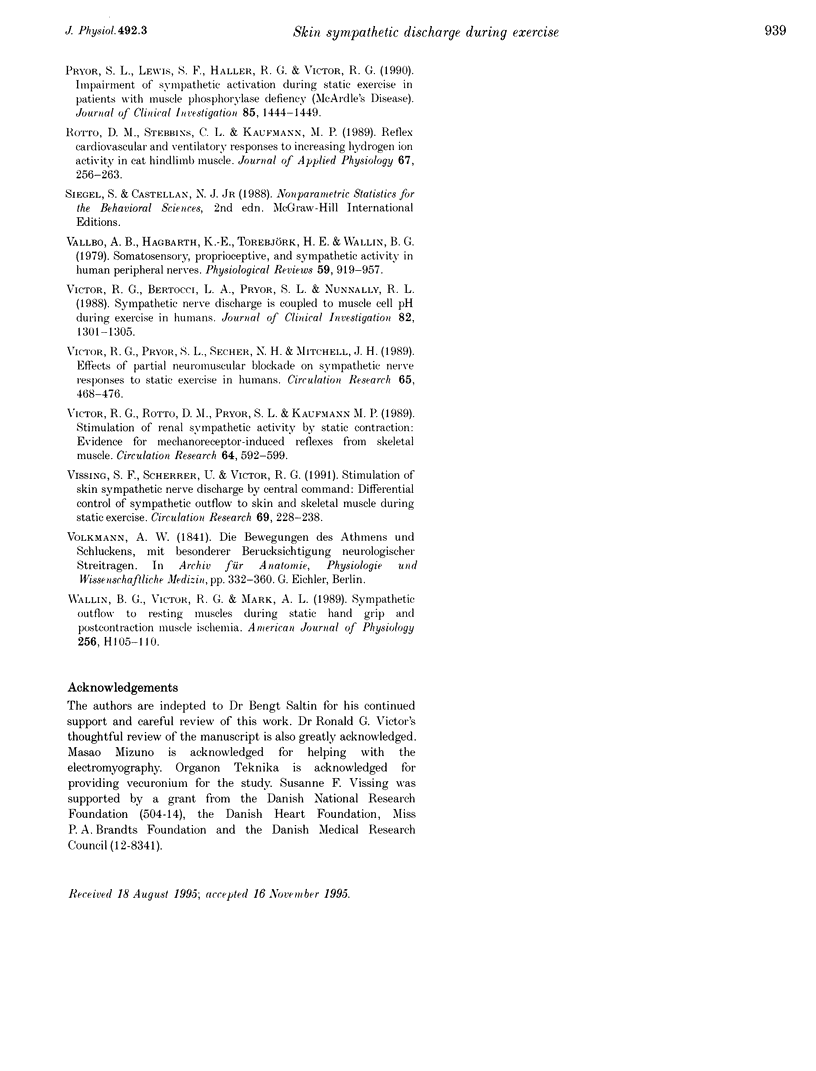
Selected References
These references are in PubMed. This may not be the complete list of references from this article.
- Alam M., Smirk F. H. Observations in man upon a blood pressure raising reflex arising from the voluntary muscles. J Physiol. 1937 Jun 3;89(4):372–383. doi: 10.1113/jphysiol.1937.sp003485. [DOI] [PMC free article] [PubMed] [Google Scholar]
- Borg G. Perceived exertion as an indicator of somatic stress. Scand J Rehabil Med. 1970;2(2):92–98. [PubMed] [Google Scholar]
- Decety J., Jeannerod M., Durozard D., Baverel G. Central activation of autonomic effectors during mental simulation of motor actions in man. J Physiol. 1993 Feb;461:549–563. doi: 10.1113/jphysiol.1993.sp019528. [DOI] [PMC free article] [PubMed] [Google Scholar]
- Eldridge F. L., Millhorn D. E., Waldrop T. G. Exercise hyperpnea and locomotion: parallel activation from the hypothalamus. Science. 1981 Feb 20;211(4484):844–846. doi: 10.1126/science.7466362. [DOI] [PubMed] [Google Scholar]
- Freyschuss U. Cardiovascular adjustment to somatomotor activation. The elicitation of increments in heart rate, aortic pressure and venomotor tone with the initiation of muscle contraction. Acta Physiol Scand Suppl. 1970;342:1–63. [PubMed] [Google Scholar]
- Krogh A., Lindhard J. The regulation of respiration and circulation during the initial stages of muscular work. J Physiol. 1913 Oct 17;47(1-2):112–136. doi: 10.1113/jphysiol.1913.sp001616. [DOI] [PMC free article] [PubMed] [Google Scholar]
- Mark A. L., Victor R. G., Nerhed C., Wallin B. G. Microneurographic studies of the mechanisms of sympathetic nerve responses to static exercise in humans. Circ Res. 1985 Sep;57(3):461–469. doi: 10.1161/01.res.57.3.461. [DOI] [PubMed] [Google Scholar]
- Pryor S. L., Lewis S. F., Haller R. G., Bertocci L. A., Victor R. G. Impairment of sympathetic activation during static exercise in patients with muscle phosphorylase deficiency (McArdle's disease). J Clin Invest. 1990 May;85(5):1444–1449. doi: 10.1172/JCI114589. [DOI] [PMC free article] [PubMed] [Google Scholar]
- Rotto D. M., Stebbins C. L., Kaufman M. P. Reflex cardiovascular and ventilatory responses to increasing H+ activity in cat hindlimb muscle. J Appl Physiol (1985) 1989 Jul;67(1):256–263. doi: 10.1152/jappl.1989.67.1.256. [DOI] [PubMed] [Google Scholar]
- Vallbo A. B., Hagbarth K. E., Torebjörk H. E., Wallin B. G. Somatosensory, proprioceptive, and sympathetic activity in human peripheral nerves. Physiol Rev. 1979 Oct;59(4):919–957. doi: 10.1152/physrev.1979.59.4.919. [DOI] [PubMed] [Google Scholar]
- Victor R. G., Bertocci L. A., Pryor S. L., Nunnally R. L. Sympathetic nerve discharge is coupled to muscle cell pH during exercise in humans. J Clin Invest. 1988 Oct;82(4):1301–1305. doi: 10.1172/JCI113730. [DOI] [PMC free article] [PubMed] [Google Scholar]
- Victor R. G., Pryor S. L., Secher N. H., Mitchell J. H. Effects of partial neuromuscular blockade on sympathetic nerve responses to static exercise in humans. Circ Res. 1989 Aug;65(2):468–476. doi: 10.1161/01.res.65.2.468. [DOI] [PubMed] [Google Scholar]
- Victor R. G., Rotto D. M., Pryor S. L., Kaufman M. P. Stimulation of renal sympathetic activity by static contraction: evidence for mechanoreceptor-induced reflexes from skeletal muscle. Circ Res. 1989 Mar;64(3):592–599. doi: 10.1161/01.res.64.3.592. [DOI] [PubMed] [Google Scholar]
- Vissing S. F., Scherrer U., Victor R. G. Stimulation of skin sympathetic nerve discharge by central command. Differential control of sympathetic outflow to skin and skeletal muscle during static exercise. Circ Res. 1991 Jul;69(1):228–238. doi: 10.1161/01.res.69.1.228. [DOI] [PubMed] [Google Scholar]
- Wallin B. G., Victor R. G., Mark A. L. Sympathetic outflow to resting muscles during static handgrip and postcontraction muscle ischemia. Am J Physiol. 1989 Jan;256(1 Pt 2):H105–H110. doi: 10.1152/ajpheart.1989.256.1.H105. [DOI] [PubMed] [Google Scholar]


